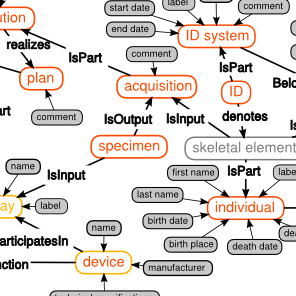
Semantic Modelling of Osteological Research Data
Making Research Explicit
© 2022. All rights reserved.
Biological Anthropologists combine a wide variety of evidence to understand how humans have evolved to what they are today. Their research involves a multitude of methods to analyse diverse materials from both living human beings and human remains. All these activities, over time, produce different types of research data that need to be related to each other in order to achieve comprehensive understanding.
We are seeking answers to these questions by describing anthropological research with semantic data models. These models exclusively describe how different data items relate to each other and how this adds to scientific understanding. Definitions of data items and documentation of research processes are integrated into these models so that they are retained, even if data models are changed in order to address new scientific problems. On the purely conceptual level of semantic data models, information from different sources (e.g. databases) can be merged purely on the basis of their meaning, independently of the database technologies used to administrate the original sources.
Semantic data models can be described as network graphs constituted of data entities (aka ‘classes’) that are linked by a specified set of relation types (aka ‘properties’). A network graph describing a specific area of knowledge is referred to as an ontology. In other life sciences, semantic models have long been used to describe scientific data. As a consequence, a broad range of domain ontologies are available with a huge utilisation potential in biological anthropology.
Biological anthropologists producing scientific evidence
can use semantic data models to document their research and resulting data with utmost efficiency and ensure that they retain their value for a long time to come.
Research projects in biological anthropology
can use semantic data models to document the process of combining research data from various sources while retaining their specific background information.
Scientific collections in biological anthropology \ can use semantic data models to keep track of diverse research conducted on the specimen under their curation.